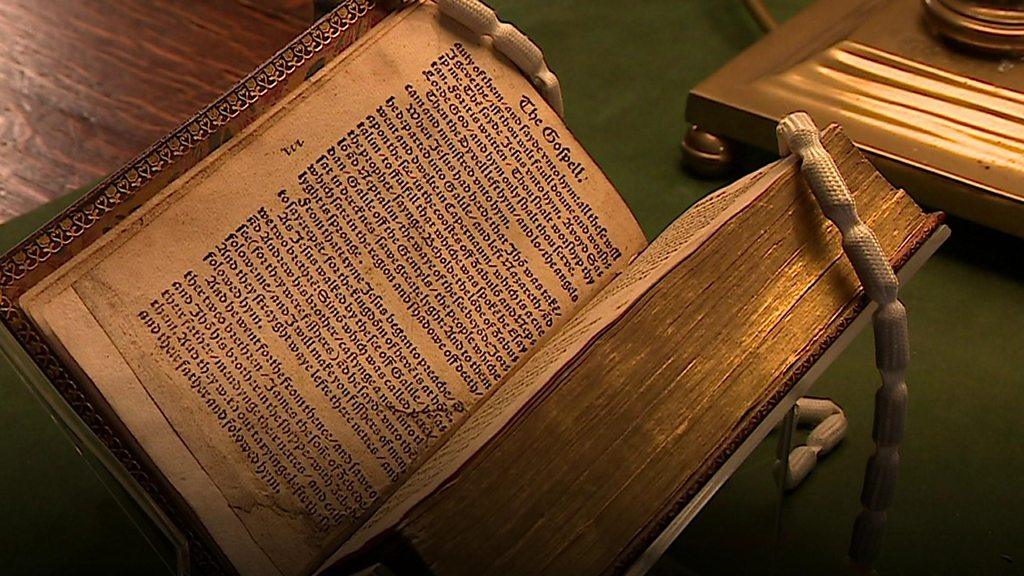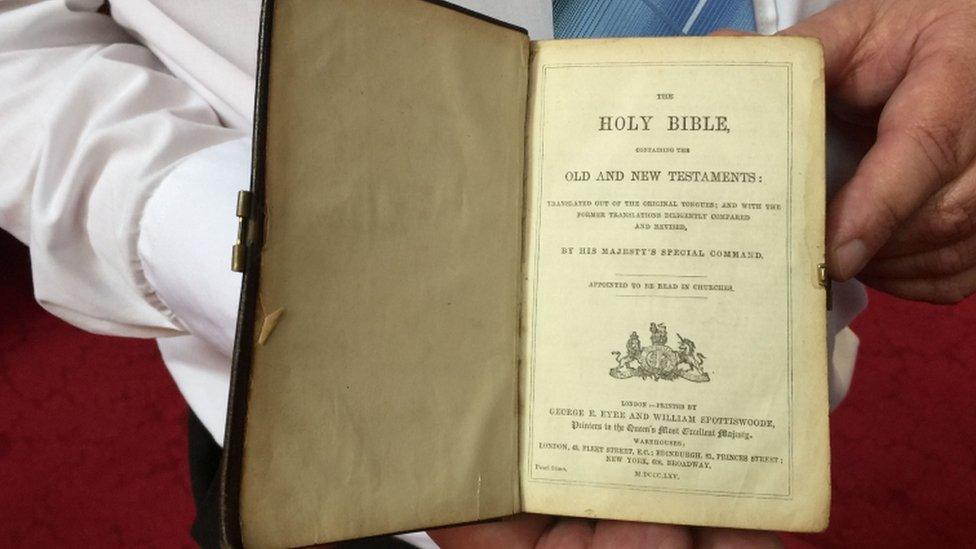Llanwnda Bible damaged in last invasion of Britain on display
- Published
The bible survived the last invasion of the UK mainland
Like many approaching a 400th birthday, it is starting to wear a little around the edges.
But, all things considered, the 1620 Llanwnda Bible is in pretty good nick.
For almost four centuries it resided at St Gwyndaf's Church in the Pembrokeshire village of Llanwnda.
It survived, most notably, the last enemy invasion on British soil.
The invaders - a force made up 600 elite French troops backed by 800 Irish irregulars and conscripted French royalists - landed on the nearby shore in 1797 and immediately began pillaging local properties.
Cold and hungry, the soldiers smashed up pews in St Gwyndaf's for a fire and tore pages out of a nearby bible with which to light it.
Historians believe the holy pages were also used as toilet paper by the soldiers.
Although the invasion was seen off within 24 hours, what remained of the bible faced a more durable enemy - time.

The bible has been kept in protective storage for two years
For more than 200 years, the surviving pages of the Llanwnda Bible - about 60% of the complete tome - remained at the church.
In the 1990s, it was found at the back of the church, wrapped in a black plastic bin liner, according to current vicar of St Gwyndaf's, the Rev Sarah Geach.
"The story goes that the book was rediscovered at the back of the church in the 1990s and nobody realised what it was," said Rev Geach.
"The parish made a cabinet but of course they were not able to store it under the right conditions and over a period of time it started to deteriorate."
So, two years ago, senior figures at the Diocese of St David's decided it needed a break from the damp conditions in the church and handed it over to conservators at the University of Wales' Trinity St David's Lampeter campus, Ceredigion.
It remained inside the university's rare books strong room, where temperatures are kept at a constant 15C and humidity levels stay at 60%, while it dried out.
The two-year "sleep" has revitalised the leather-bound bible and this week it reappeared in public as an exhibit in the university's Roderic Bowen Library, where it has been keeping company with 35,000 other rare books, some from the early 13th century.
'One of the oldest in Wales'
The bible, printed in Welsh, is being kept inside a locked glass cabinet near the library entrance throughout January.
Next month, it is being moved to the National Library of Wales in Aberystwyth, Ceredigion, where conservators will carry out further preservation work, including fumigation treatments, on the ancient bible.
Dr John Morgan-Guy, honorary research fellow at Trinity St David's, said the bible was one of the oldest in Wales.
He added: "What makes it unique is its association with the last invasion on British soil all those years ago.
"It did well to survive when you consider what it must have been through.
"Expert analysis of the bible suggests these soldiers grabbed it by the hard cover and tore the bindings, which were made of wood and thick, strong string, from the paper with considerable force.
"They then ripped handfuls of sheets from the bible and used them to start a fire outside so they could cook food and keep warm.
"Alas, some of the sheets were used for more basic purposes by the soldiers.
"Thankfully, a large part of the bible has survived and now we have to continue to conserve what we have. We do not want to restore it because its interest lies in what happened to it as much as what it is."

Dr Morgan-Guy, who is a retired lecturer in church history at the university and its former chaplain, added: "If it had been left at St Gwyndaf's, it would only have disintegrated further, due to the elements.
"When it goes back to the church later this year, it will be kept inside a temperature and humidity-controlled glass cabinet and it will be on display for everyone once again for many centuries to come, I hope."
- Published23 November 2017

- Published10 October 2017

- Published5 August 2017
